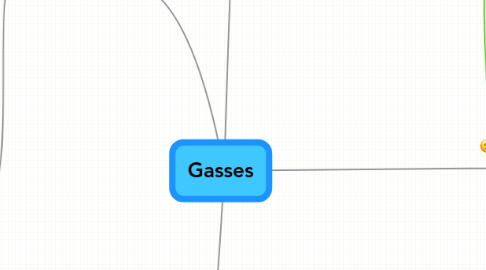
1. Nitrogen
1.1. Properties
1.1.1. Very inert (unreactive) gas
1.2. Uses
1.2.1. Making ammonia in Haber.
1.2.2. Creates inert atmosphere in food packaging to protect it oxidation of food. Preserves it for a long time
1.3. How to prepare it in Lab?
1.3.1. Heat ammonium chloride and calcium hydroxide together.
1.3.2. The gas is then passed through solid calcium oxide to dry it.
1.3.3. The gas is collected by upward delivery (lighter than air).
1.3.4. Equation of reaction
1.3.4.1. Word
1.3.4.1.1. Ammonium chloride(aq)+Calcium hydroxide(aq)= Ammonia(g)+Water(g)+Calcium chloride (aq)
1.3.4.2. Symbol
1.3.4.2.1. 2NH4Cl + Ca(OH)2 = 2NH3 +2H2O + CaCl2
1.3.5. Test for Nitrogen/Ammonia
1.3.5.1. Red litmus paper turns blue when gas passes through
1.4. Ammonia
1.4.1. Properties
1.4.1.1. Colourless alkaline gas. Less dense than air.
1.4.1.2. Very soluable in water
1.4.2. Solubility
1.4.2.1. Dissociates (split) water into 2 ions.
1.4.2.1.1. The ions are NH4+ and OH-
1.4.2.1.2. Ammonia(g) +water(l)=Ammonium Ion(aq) +hydroxide ion (aq)
1.4.3. Salts
1.4.3.1. These salts are created to act as fertilisers
1.4.3.1.1. Ammonia solution (aq) + dilute sulphuric acid(aq)= Ammonium sulphate(aq)
1.4.4. Test
1.4.4.1. Add dilute sodium hydroxide. Heat gently. Gas given off. If litmus paper turns blue, there is an ammonium ion present.
2. Hydrogen
2.1. Dilute Acids on Metals
2.1.1. metal + acid = hydrogen + a salt
2.1.1.1. Salts named from Acid
2.1.2. Order of Reactivity
2.1.2.1. Magnesium
2.1.2.2. Aluminium
2.1.2.3. Zinc
2.1.2.4. Iron
2.2. Preparation in Lab
2.2.1. Dilute Hydrochloric Acid + Zinc
2.2.1.1. Granulated Zinc
2.2.1.2. HCl (aq)
2.2.1.3. React both together and collect H2 in a test tube up-side down in a water bath
2.2.1.3.1. H2 is lighter than Air
2.3. Combustion 2H2 (g) + O2 (g) = 2H2O (l)
2.3.1. Tests with lighted splint
2.3.1.1. H2 burns in O2
2.3.1.2. Makes a 'pop' sound
2.4. Chemical Test for H20
2.4.1. H20 turns CuSO4, a white powder, blue
2.4.1.1. Symbol Equation
2.4.1.1.1. CuSO4 (s) + 5H20 (l) = CuSO4.5H20 (s)
2.4.2. H20 crystallisation is added
2.4.3. Makes blue crystals
2.5. Physical Test to show if H20 is PURE
2.5.1. Test boiling point
2.5.1.1. 100 degree Celcius
2.6. H2 + Cl2
2.6.1. All halogens + hydrogen = hydrogen halides
2.6.1.1. When H2, reacts with Cl2 while heating - sunlight/ultraviolet light, there can be an explosion
2.6.1.1.1. H2 (g) + Cl2 (g) = 2HCl (g)
3. Sulphur
3.1. Sulphites + Dilute Acid
3.1.1. SO2 dissolves in H20 = H2S03
3.1.2. Salts of H2S03 = sulphites
3.1.3. Sulphites + Dilute acid = Sulphur dioxide
3.1.3.1. Uses of SO2
3.1.3.1.1. Sulphuric Acid
3.1.3.1.2. Preservatives
3.1.3.1.3. Wine Making
3.1.3.1.4. Reducing agent
3.1.4. Example
3.1.4.1. Word Equation
3.1.4.1.1. Potassium Sulphite + Nitric acid = Sulphur dioxide + Potassium Nitrite + Water
3.1.4.2. Symbol Equation
3.1.4.2.1. K2SO3 (s) +2HNO3 (aq) = SO2 (g) + 2KNO3 + H20 (l)
3.1.5. Test for Sulphites
3.1.5.1. Dilute HCl and Barium Chloride = white precipitate
3.2. Allotropes
3.2.1. 3 MAIN forms
3.2.1.1. Rhombic
3.2.1.1.1. Properties
3.2.1.2. Monoclinic
3.2.1.2.1. Properties
3.2.1.3. Plastic
3.2.1.3.1. Properties
3.3. 2/3 of Sulphur in atmosphere comes from sulphurous gases emitted by volcanoes
4. Oxides
4.1. Oxygen
4.1.1. Industrial extraction of oxygen
4.1.1.1. Air is cooled to -80 degrees Celsius to solidify and then remove carbon dioxide and water
4.1.1.2. Air is cooled and compressed
4.1.1.3. Allowed to expand quickly, which cools it down further
4.1.1.4. Air is now -200 degrees Celsius. Air is now liquefied.
4.1.1.5. Liquid air is then fractionally distilled because the gasses have different boiling points.
4.1.1.5.1. Oxygen Boiling Point:-183 degrees Celsius
4.1.1.5.2. Nitrogen Boiling Point:-196 degrees Celsius.
4.1.2. Reactions of oxygen in air.
4.1.2.1. Basic Oxides
4.1.2.1.1. Magnesium(s) + Oxygen(g)=Magnesium oxide(s)
4.1.2.2. Acidic Oxides
4.1.2.2.1. Sulphur(s) + Oxygen(g)=Sulphur dioxide(g)
4.1.3. Determining the percentage by volume of oxygen in air
4.1.3.1. Contains 100cm3 of air.
4.1.3.2. Gas is continually passed from one syringe to the other and over the copper in the silica tube
4.1.3.3. Amount of air decreases because the copper reacts with the oxygen.
4.1.3.4. We know that 21cm3 of oxygen was used and 79cm3 was left.
4.2. Carbon Dioxide
4.2.1. Uses
4.2.1.1. Fizz Drinks
4.2.1.1.1. Added under Pressure
4.2.1.2. Fire Extinguishers
4.2.1.2.1. Denser than Air
4.3. Rusting of Iron
4.3.1. Corrode
4.3.1.1. Broken Down chemically + Decay
4.3.1.1.1. Rusting
4.4. Sulphur dioxide and combustion
4.4.1. Sulphur burnt in Oxygen
4.4.2. Reacts with water to make sulphurous acid
4.4.2.1. SO2 + H20 = H2S03
4.4.3. Atmosphere, SO2 reacts with O2
4.4.3.1. Symbol Equation
4.4.3.1.1. Sulphur Dioxide + Oxygen + Water = Sulphuric Acid + Water
4.4.3.2. Word Equation
4.4.3.2.1. 2S02 (g) + O2 (g) + 2H2O (l) = H2SO4 (aq) + H20 (l)
